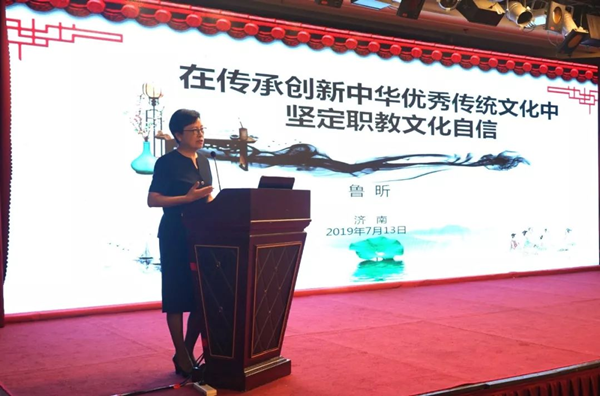
Lu Xin, president of the Chinese Society of Technical and Vocational Education and former vice-minister of education, speaks at a symposium on vocational education in Jinan, capital city of East China's Shandong province, on July 13, 2019. [Photo/lubanworkshop.cn]
Expert called to take root in and find essence from traditional Chinese culture in a move to better interpret the modern values for vocational education.
Moreover, an explanation of traditional Chinese craftsmanship with the spirit of Lu Ban and Mo Zi as the mainstay must be conducted with a firm faith in traditional Chinese culture, technological progress in human history, inheritance and innovation of Chinese civilization, and the contributions of traditional Chinese crafts.
Lu Xin, president of the Chinese Society of Technical and Vocational Education and former vice-minister of Education, expressed those ideas at several recent symposiums.
Lu Ban lived during the late Spring and Autumn Period (770-476 BC) and the early Warring States Period (475-221 BC). He was famous for creating numerous carpentry and agricultural tools, as well as traditional architecture and military machinery, and is thus revered as China's master craftsman.
Mo Zi, also named Micius, lived in the same period as Lu Ban. Apart from inventing many practical tools such as carriage axles, wooden birds and scaling ladders, he was also reputed for his achievements in the disciplines of geometry, mechanics and optics.
Both of them came from a family of craftsmen. They made relentless efforts to hone their techniques and are regarded as the embodiment of professional and technical excellence in traditional Chinese culture.
An inheritance and innovation of the craftsmanship spirit of Lu Ban and Mo Zi should be upgraded with additional elements which underscore the importance of product quality, dedication, perseverance, professionalism, excellence, integrity, a customer-oriented service spirit and innovation, in the new era in a move to better align with China's new normal development stage.
The craftsmanship spirit of Lu Ban and Mo Zi is not only a treasure in traditional Chinese culture but also a cultural engine to facilitate the transformation of China from a major manufacturing country to a great manufacturing country.
Therefore, Lu said, China’s vocational institutes should practice the craftsmanship spirit of Lu Ban and Mo Zi, as the craftsmanship spirit is closely related to personnel training. Consequently, the vocational education should take the cultivation of high-quality skilled personnel as the mission.
Lu added that vocational institutes are expected to perform well in the following aspects:
· Attach great importance to the historical values and significance of the craftsmanship spirit of Lu Ban and Mo Zi. Further enrich the connotations of the craftsmanship spirit in accordance with their features and integrate new elements with operational mindsets, orientations and practice;
· Plant the awareness of high-quality products and the craftsmanship spirit in the heart of teachers. Encourage them to master both solid theories and excellent skills in a move to nurture their students into a knowledgeable, skilled, innovative and modern labor force;
· Integrate the craftsmanship spirit of Lu Ban and Mo Zi with personnel training. Pilot modern apprenticeships, and reform the personnel training model. Strengthen collaboration between vocational institutes and enterprises and cooperation between teachers and skilled workers, in a bid to comprehensively practice the craftsmanship spirit both in classrooms and internship workshops;
· Practice the craftsmanship spirit in the "second" class. Invite craftsmen and model laborers to visit students on their campuses with the aim of further promoting the spirit of model workers and craftsmanship. Hold themed campus contests to allow skilled practitioners to demonstrate their technique and professional practice and build an atmosphere in which a glory of labor, the importance of skills and the greatness of innovation are stressed.
Moreover, the development of vocational education should be closely rooted in the practice of the craftsmanship spirit of Lu Ban and Mo Zi and follow the latest changes in the employment prospects.
Although vocational education is highly sensitive to new demands arising from the talent market and is expected to undergo reform in the process, yet its reform should always stick to the craftsmanship spirit of Lu Ban and Mo Zi, which is the embodiment of their actual practice, technological innovation and invention; all crucial to personnel training in vocation education.
And finally, said Lu, the craftsmanship spirit of Lu Ban and Mo Zi must be utilized to consolidate cultural confidence in vocational education. It’s a ever-lasting theme and the fundamental root and essence of vocational education to help vocational educators adhere to their original aspirations, cultivate a group of skilled workers and masters, promote innovation in vocational education, make humanistic care accessible to children from medium- and low-income families and other underprivileged populations now and in the future.



